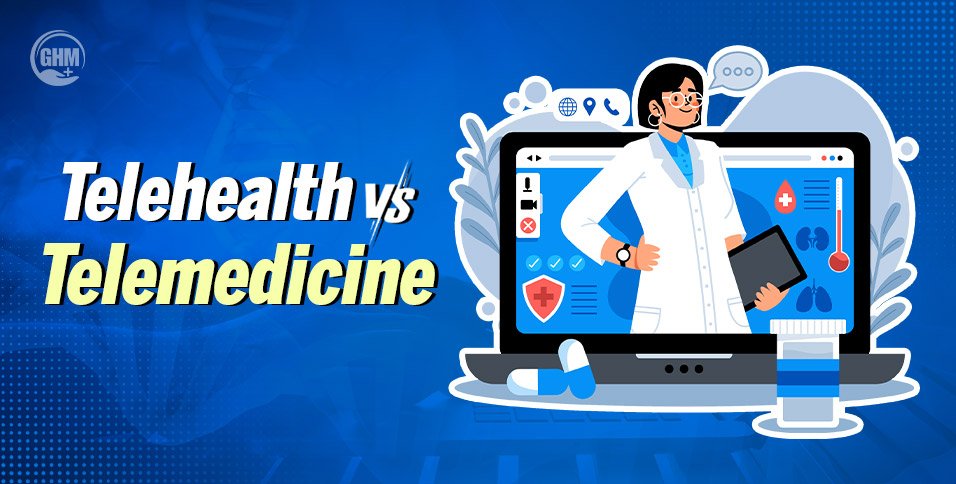“Healthcare doesn’t need to be high-tech to feel human. But it must be smart enough to reach everyone.”
Virtual healthcare is no longer the future. It’s the present—and it’s growing fast. Since the pandemic, people now book doctor visits from their couches. Wearables track vitals. Health tips arrive on phones. But with all this growth, one question keeps popping up: what’s the difference between telehealth vs telemedicine?
Many use the terms interchangeably. But they aren’t the same. This blog breaks it down clearly. We’ll explain both terms, point out what makes them different, and demonstrate why this difference is more important than many realize.
Because here’s the truth: knowing the line between telehealth and telemedicine impacts how we build policies, train doctors, and care for patients. From remote check-ups to public health alerts, virtual care touches everything. And when done right, it doesn’t just make healthcare digital—it makes it better.
Let’s make sense of the terms. Let’s talk real-world care, not just buzzwords.
Defining Telehealth: The Broad Spectrum of Digital Health Services
Let’s make one thing clear right at the start: telehealth is not just online doctor visits. It’s way bigger than that.
Telehealth is like a digital doorway to healthcare. From checking your blood pressure at home to getting a medicine reminder on your phone—it’s all part of it. While people often mix up telehealth vs telemedicine, there’s a key difference. Telehealth includes medical care, yes, but also everything that supports it.
Here’s what falls under telehealth:
- Remote monitoring: Think of devices tracking your sugar levels and sending it to your doctor in real time.
- Mobile health apps: Simple tools that remind you to walk, breathe, or take your meds.
- Online training for doctors: Because even doctors need classes sometimes.
- Digital public health: Campaigns that reach millions through one tap.
- Patient education: Like YouTube, but for your health.
Now the numbers: the telehealth market is expected to touch $196.8 billion in 2025, growing at 22.6% CAGR. RPM alone? A massive $71.1 billion.
So, when it comes to telehealth vs telemedicine, think big. Telehealth covers it all. Telemedicine is just one part of its giant digital toolkit.
Defining Telemedicine: Focused Clinical Care at a Distance
Here’s where we draw the line.
Telemedicine is not some fancy term for a video chat. It’s real clinical care—diagnosis, treatment, follow-ups—delivered without stepping into a hospital. Simple as that.
Now, when people talk about telehealth vs telemedicine, they often bundle them up. But the difference is clear. Telemedicine is focused. It’s where actual medical decisions happen, not just tracking, teaching, or reminders.
What does it include?
- Video consultations. For infections, allergies, or post-op care, your doctor meets you on screen.
- Store-and-forward tools. You send a report, a scan, or an image. The doctor checks and responds when ready.
- Remote monitoring. Heart conditions, blood pressure, or oxygen levels—monitored live, from home.
- E-consults between doctors. Your primary care provider gets specialist input without sending you anywhere.
Now to the numbers that matter: the telemedicine market is set to cross $111.99 billion in 2025. And it’s only getting bigger—$334.8 billion by 2032, growing steadily at 16.9% CAGR.
So, in the telehealth vs telemedicine split, think of telemedicine as the core. It’s where the care actually happens—no waiting room, no commute, just focused clinical action on your terms.
Telehealth vs. Telemedicine: A Side-by-Side Comparison
| Feature | Telehealth | Telemedicine |
| Scope | Broader, umbrella term | Narrower, clinical focus (subset of telehealth) |
| Services | Clinical & non-clinical | Exclusively clinical (diagnosis, treatment, etc.) |
| Participants | Wide range of healthcare professionals (doctors, nurses, therapists, educators, administrators) | Primarily licensed medical practitioners (doctors, PAs, NPs) |
| Examples | Remote monitoring, patient education, admin meetings, CME, inter-provider communication, virtual mental health support | Virtual doctor visits, remote diagnosis, e-prescribing, specialist consultations, remote chronic disease management |
| Goals | Improve healthcare delivery & access comprehensively | Provide direct medical care from a distance |
Shared Benefits of Virtual Care (Telehealth & Telemedicine)
So, what’s the real win here?
Whether it’s telehealth or telemedicine, virtual care is solving problems we’ve ignored for too long. It’s faster, simpler, and finally puts the patient first.
Let’s start with access.
Millions live hours away from specialists. With one click, that gap disappears. Rural areas, homebound patients, or someone without transport—virtual care brings the doctor to them. That’s a game changer.
Then there’s time and cost.
Patients skip travel, long waits, and clinic queues. Providers save on overhead. Everyone saves hours. Studies show telemedicine cuts emergency room visits by up to 19%. That’s not just efficient—it’s money saved.
What else improves?
- Chronic disease care. Regular check-ins become easy.
- Faster interventions. You feel sick, you get seen—now.
- Less exposure. Flu season? You stay home.
- Flexible scheduling. Appointments work around life, not the other way around.
Now, here’s the big number: Together, telehealth and telemedicine will drive over $300 billion in value by 2025.
So when we talk telehealth vs telemedicine, it’s not just a definition thing. It’s about what they bring to the table—reach, relief, and results. And frankly, it’s about time healthcare caught up to how people actually live.
Policy, Reimbursement, and Regulatory Landscape
Behind every virtual visit, there’s paperwork.
It’s not enough for telehealth to work well. If policies don’t support it, or insurers won’t pay for it, it stalls. And that’s where telehealth vs telemedicine becomes more than just a healthcare debate—it turns into a legal and financial issue.
First, definitions vary by state and agency. That means what counts as telehealth in one state might not qualify in another. And that affects both licensing and reimbursement.
Right now, Medicare and Medicaid have extended flexibilities through 2025. This includes allowing audio-only care, cross-state services, and a wider range of providers, like physical therapists and mental health counselors.
But here’s the problem: payment parity is still inconsistent. Some private insurers reimburse virtual care just like in-person visits. Others don’t. That creates confusion and gaps, especially for small practices trying to invest in digital care.
Even worse? Cross-state licensing is still messy. A doctor licensed in Texas can’t always treat a patient in Florida. That hurts continuity of care.
So, understanding telehealth vs telemedicine isn’t just about who does what. It’s about knowing how rules shape access, pricing, and trust. Without a strong policy, even the best tech can’t reach the people who need it most.
VII. Essential Considerations for Trustworthy Virtual Care
Just because it’s digital doesn’t mean it’s dependable.
Virtual care only works when people can trust it. Not just the technology, but the entire experience. And when we talk telehealth vs telemedicine, trust isn’t optional. It’s the foundation.
So what makes virtual care trustworthy?
- Privacy, first. If your health data isn’t protected, nothing else matters. Platforms must follow HIPAA, encrypt everything, and guard your information like it’s gold—because it is.
- Reliable tech. Glitchy calls and slow signals break more than just audio. They break trust. But here’s the thing—millions still don’t have high-speed internet, especially in rural and low-income homes. That’s a gap we can’t ignore.
- Knowing the limits. Virtual care is amazing—but it’s not magic. Emergencies? Physical exams? Surgery? That’s where in-person care takes over. And that’s okay.
- Fair access. If only some people can use it, then we’re not doing it right. Virtual care should lift everyone, not leave anyone behind.
And when we really look at telehealth vs telemedicine, here’s the truth: neither works without people feeling safe, seen, and supported. Not just with smart tools, but with smart systems built to care.
Key Takeaways
Virtual care isn’t new anymore; it’s the new normal now, unlike many other things. But that doesn’t mean it’s simple.
Every year, more people turn to screens for answers. Yet most still don’t know where telehealth vs telemedicine actually split. That’s not a small detail. That’s the starting point.
Telehealth brings in the tools—the education, the tracking, the public health reach. Telemedicine? That’s the treatment room. It’s where symptoms meet diagnosis. One isn’t better, they just serve different needs.
But even with that growth, the system has gaps. Rules shift from state to state. Payments don’t always match effort. And access? Still uneven.
So here’s what really matters: tech alone won’t fix care. If trust breaks—even once—people step back. If a patient feels unheard or a doctor feels limited, the screen creates a barrier instead of a bridge.
And maybe that’s the bigger point. This isn’t about digital vs traditional. It’s about what works. And who it work for?
Because the real future of healthcare? It’s not in the tools. It’s in how they’re used—and who gets to use them.


















